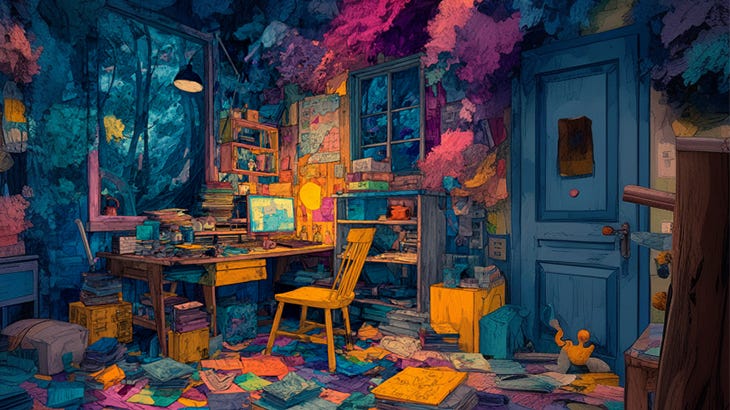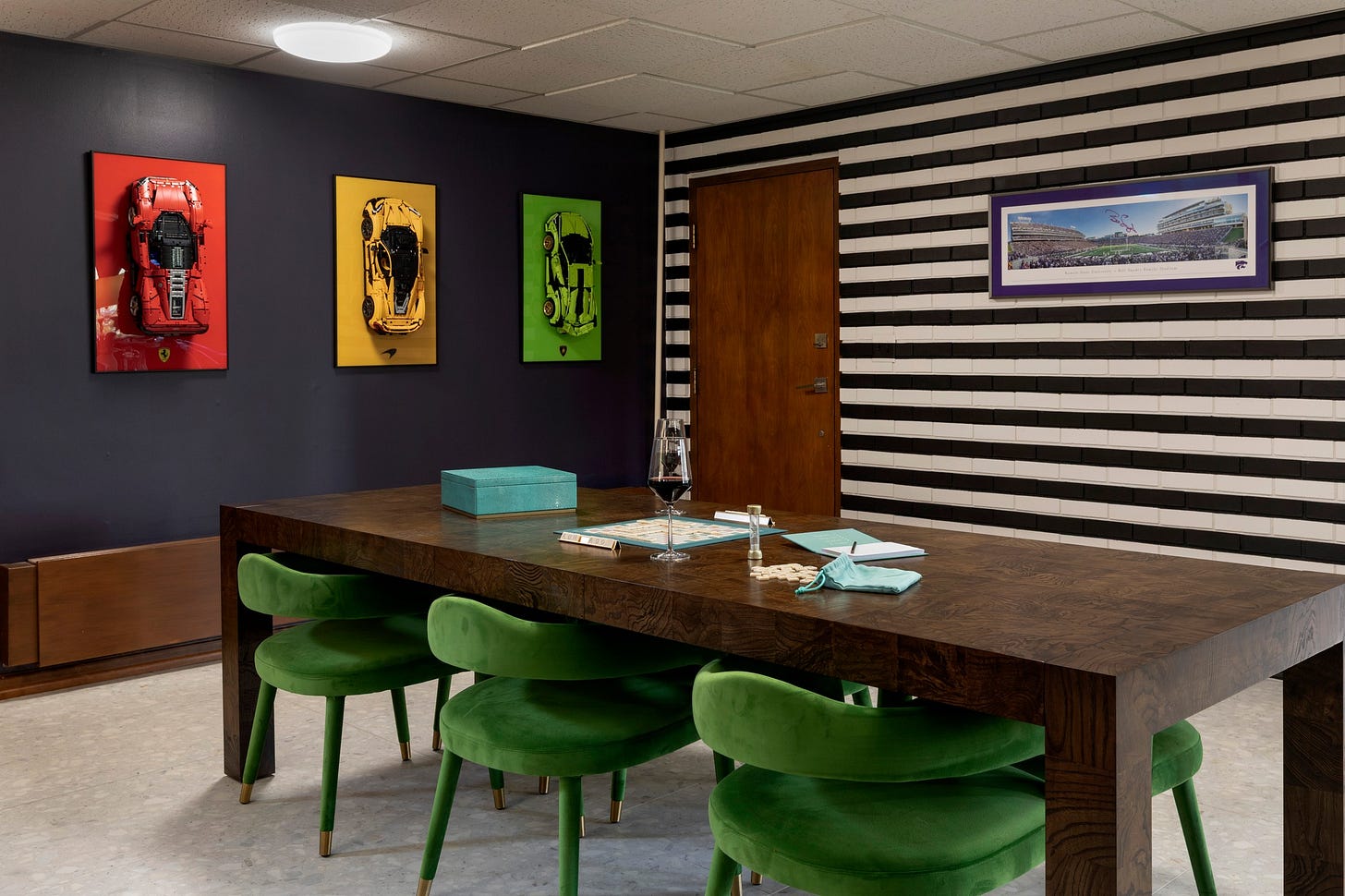Designing Mindful Workspaces for Neurodiverse Minds
Practical thoughts on crafting a home office that supports focus and creativity.
Take a moment to visualize grabbing your backpack and heading off to work … at the top of a trash pile in a garbage dump.
It’s easy to think just how poorly that would influence the next action you take, no matter the goals you had in mind. Just imagine the smell and hearing the persistent low rumble of the dump trucks in the distance; the bugs flying around your head. This is a sort of worst case scenario of a poor working environment, but you can sense how much this would drive our behavior for the day. No amount of willpower is going to overcome the distractions that are outside of your control.
Low quality environments
Shortly after I left the military—where I encountered the worst working environments of my life—I became relentless about curating a positive environment. Being married to an interior designer helps with understanding the influence space has on our mental wellbeing. On the neurodivergent side, it’s also something I find critical in helping me maintain focus and getting into a productive mindset.
After college, I had a short stint in a corporate environment at a Disney-owned company. They had just remodeled old aircraft hangars, which immediately connected with my military background and my Wichita roots (the Air Capital of the World). We had two old hangars on Hamilton Air Force Base in Novato, California. After the remodel, everything looked so clean. White walls everywhere, exposed iron beans across the ceiling, floor to ceiling windows that wrapped the entire floor. Fresh carpet and … a surprisingly few pieces of artwork for a movie studio. It was largely contained of open spaces and large cubical farms with engineers stuffed into a shared room.
Disney ended up closing that studio and my wife and I headed back to Kansas to become independent contractors. All of a sudden, we were faced with creating a home environment that also needed to be morphed into a nice work environment.
We knew that to do our best work we need goals, time to focus on them, and a high quality workspace that helps our conscious and subconscious mind get into action.
Finding the light
As someone with learning and attention challenges, a chaotic home environment creates an atmosphere that makes it difficult to focus. If I can’t find what I need, when I need it, the lack of organization is getting in the way. It is crucial to keep the work environment tidy while finding value in priming my mindset with how I approach the design of the space.
Natural light is a key component that I think about often. I already make it a goal to get outside every morning to get early morning sunlight into the eyes to “wake up” the internal clock (our circadian rhythm). Of course, don’t go looking directly at the sun, but face in the general direction for five to ten minutes. We want as much of that natural light to flow through the home and office throughout the day, so it becomes critical to think about when looking for a home to rent or buy.
There’s a lot of research out there on sunlight, but it’s important to consider how it makes you feel. It pays to be mindful as you carry on through the day to see if you notice the subtle effects — improved mood, increases energy, and so on. Does it make you happy to be in the sun? Well, that might just be helping you with depression and anxiety!
Turning down the noise
If you are in a loud and distracting environment you are going to have a hard time focusing on the necessary tasks. I can understand why an open office environment is so detrimental to productivity. All of a sudden, people have to find other ways to prevent distractions by using head phones and listening to music. That becomes a problem when you can’t listen to music while you work—a state I found myself in from 2019 to 2024. During that time, I found music to be incredibly distracting—especially when the track contained words.
Finding the essentials
I spend a lot of time decluttering and organizing my office environment so it feels like a place I want to be. A disorganized office really impacts my ability to focus, so I organize the desk with minimal distractions. It also prevents the space from becoming a source of overwhelm for someone with ADHD challenges. Every month, I completely clear off the desk, clean it, and ask whether I need the things on it. Everything has its place. My daily planner is in the same spot every day, as are the notebooks that I use to take notes during meetings.
There is even an area in my office that helps me remember upcoming appointments, what I have done, and the projects I am tracking at a high level. The wall is actually cork and I can pin whatever I want to it. Some of the things I pin to it:
A large format wall calendar
Note cards that I use to sketch project ideas on
Images of game art that I use for inspiration
Motivational reminders
I imagine most walls are not made of cork (this was an old architects home), so you might consider a white board. The point is to have some way to keep things you care about in sight.
Introducing dopamine decor
What I have noticed in any office I have worked in is that I look for ways to add visually interesting decor to the room. I’m not looking for bland white walls everywhere. At the same time, I’m not trying to overwhelm a space with clutter, but rather find items that invoke a positive emotion. There is actually a phrase for this:
Dopamine decorating is a design philosophy that prioritizes creating spaces that are joyful, colorful, and stimulating by incorporating elements that evoke happiness and pleasure.
In my home office, I have several things that contribute to stimulating the mind:
Inspiring quotes
High quality statues from Sideshow and LEGO pieces
Things that remind me of what I’ve done (like a movie or game I worked on)
Faux plants
I regularly revisit what I’m doing around my office because of the ADHD part of my brain. Periodic refreshes give me nice boosts to motivation. In my previous office setup, I would rotate my office so my desk would move to another wall and everything would shift. These days, I usually swap art, LEGO sets, and other small items. The months of October, November, and December is the best time of the year for this in my house.
The goal is to be adjusting the environment to help manage mood and stress. All kinds of things can have a direct influence in the way we feel when we enter a space, so it pays to focus deeply on what kind of things influence your mood when you walk into an office space, and experiment to see if something helps. Other things you might think about with your space:
Improve the air quality with a nice filter.
Add a diffuser with Holy Basil Oil.
Avoid crowding the space to avoid being overwhelmed visually.
What are the absolute essentials that you add to every office environment you go into? Imagine you just bought a home that you plan to work remotely from. What are the first things you do to the room?



